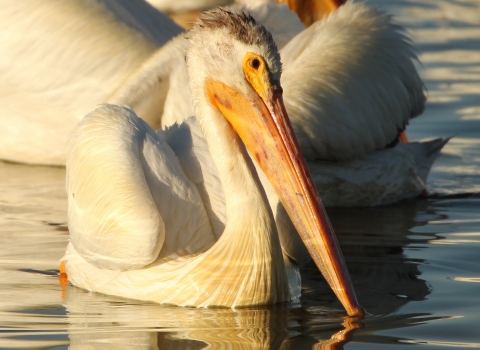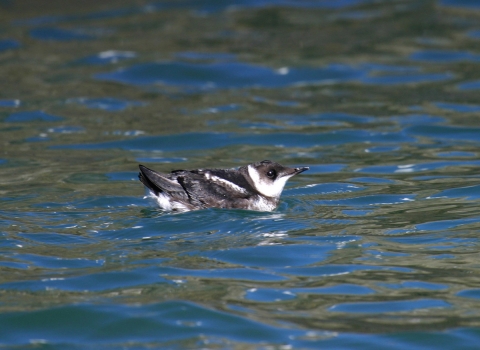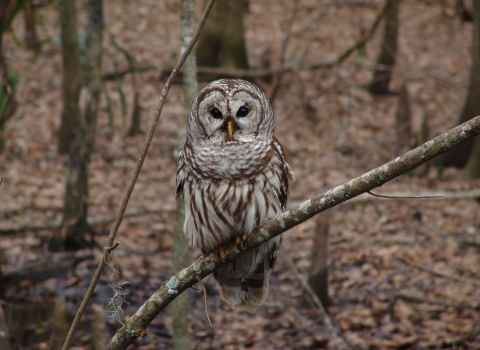Conservation Efforts Lead to Proposed Reclassification for Straight-horned Markhor under the ESA
The U.S. Fish and Wildlife Service today proposed to reclassify the straight-horned markhor, a subspecies of wild goat that inhabits the mountains of Balochistan Province, Pakistan, from endangered to threatened under the Endangered Species Act (ESA). In addition, the Service proposed a special rule for the markhor that, if adopted, would allow the import of straight-horned markhor trophies, through a limited hunting program, which will help fund successful, ongoing community-based conservation efforts.
The proposed reclassification and special rule recognizes the substantial contribution made by recovery actions now occurring in the Torghar Hills, a chain of rugged sandstone ridges located within the Toba Kakar Range in Pakistan. Here, locals have implemented a wildlife management plan called the Torghar Conservation Project (TCP), an innovative, community-based conservation program that allows for limited trophy hunting to conserve local populations of markhor, improve habitat for both markhor and domestic livestock, and improve the economic conditions for local tribes in Torghar.
The project, which has been in effect since 1985, has increased the Torghar Hills population from fewer than 200 animals in the mid-1980s to more than 3,000 animals today. This growth can be attributed to the substantial reduction in mortality that occurred when uncontrolled hunting by tribes was stopped, as well as the virtual elimination of poaching driven by the hiring of more than 80 game guards from the local population.
The Service received two separate petitions seeking to reclassify the species and allow importation of trophies, in order to support the trophy hunting conservation program. On March 4, 1999, the Service received a petition from Sardar Naseer A. Tareen, on behalf of the Society for Torghar Environmental Protection and the International Union for Conservation of Nature (IUCN) Central Asia Sustainable Use Specialist Group, requesting that the straight-horned markhor (Capra falconeri jerdoni or C. f. megaceros) population of the Torghar Hills region of the Balochistan Province, Pakistan, be reclassified from endangered to threatened under the Act. On August 18, 2010, a petition dated August 17, 2010, was received from Conservation Force, on behalf of the Dallas Safari Club, Houston Safari Club, African Safari Club of Florida, The Conklin Foundation, Grand Slam Club/Ovis, Wild Sheep Foundation, Jerry Brenner, Steve Hornaday, Alan Sackman, and Barbara Lee Sackman, also requesting reclassification.
In light of the substantial population growth in the Torghar Hills, the Service carefully assessed the best available scientific and commercial information regarding the past, present and future threats faced by this subspecies and determined that reclassifying this subspecies of markhor from endangered to threatened throughout its range is appropriate. This finding also serves as the Service’s 5-year review for this subspecies.
On March 30, 2012, a settlement agreement was approved by the Court in which the Service agreed to submit to the Federal Register by July 31, 2012, a 12-month finding on the August 2010 petition. Today’s finding satisfies that agreement.
The proposed listing reclassification, proposed special rule and status review for this subspecies will publish in the Federal Register on August 7, 2012. The Federal Register publication of this rule will be available online at http://www.fws.gov/policy/frsystem/default.cfm by clicking on the 2012 Proposed Rules under Endangered and Threatened Wildlife and Plants.
The Service intends that any final action resulting from this proposed rule will be based on the best scientific and commercial data available and be as accurate and as effective as possible. The Service particularly seeks clarifying information concerning the straight-horned markhor, including:
Information on taxonomy. Specifically, information relating to the classification of the markhor subspecies.
Information on distribution, habitat selection, diet, and population abundance and trends of this subspecies.
Information on the effects of habitat loss and changing land uses on the distribution and abundance of this subspecies.
Information on management programs for straight-horned markhor conservation, including mitigation measures related to conservation programs, and any other private, nongovernmental, or governmental conservation programs that benefit this species.
The potential effects of climate change climate change
Climate change includes both global warming driven by human-induced emissions of greenhouse gases and the resulting large-scale shifts in weather patterns. Though there have been previous periods of climatic change, since the mid-20th century humans have had an unprecedented impact on Earth's climate system and caused change on a global scale.
Learn more about climate change on this subspecies and its habitat.
Written comments and information concerning the proposed listing, proposed special rule and status review for this subspecies can be submitted by one of the following methods:
Federal eRulemaking Portal: http://www.regulations.gov. Follow the instructions for submitting comments to Docket No. FWS-R9-ES-2011-0003;
or U.S. mail or hand-delivery: Public Comments Processing, Attn: [FWS-R9-ES-2011-0003]; Division of Policy and Directives Management; U.S. Fish and Wildlife Service; 4401 N. Fairfax Drive, MS 2042–PDM; Arlington, VA 22203.
Comments must be received within 60 days, on or before October 9, 2012. The Service will post all comments on http://www.regulations.gov. This generally means the agency will post any personal information provided through the process. The Service is not able to accept email or faxes.
Addition of a foreign species to the Federal List of Endangered and Threatened Wildlife places restrictions on the importation of either the animal or its parts or products. Listing can also generate conservation benefits, such as increasing awareness of the species, prompting research efforts to address their conservation needs, or funding conservation in range countries.
The ESA provides a critical safety net for fish, wildlife and plants and to date has prevented the extinction of hundreds of imperiled species, as well as promoting the recovery of many others. The Service is actively engaged with conservation partners and the public in the search for improved and innovative ways to conserve and recover imperiled species. To learn more about the Endangered Species program’s Branch of Foreign Species, visit: http://www.fws.gov/endangered/what-we-do/international-activities.html.
Press Release
Conservation Efforts Lead to Proposed Reclassification for Straight-horned Markhor under the ESA



